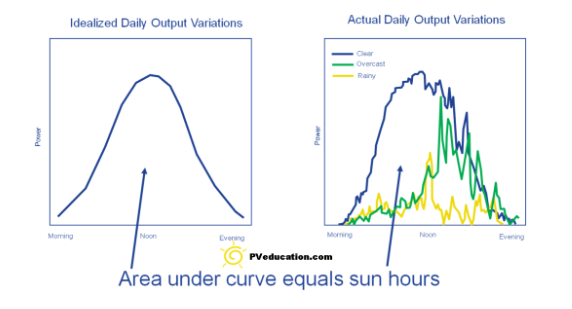I assumed that I would average 75w out of the 100w panel over 8 hrs,
The 75W output out of a 100W panel isn't the average over the day, it's the *most* you can get, period, at solar noon. It only goes down from there (output, not efficiency) other times of the day. Sun angle, panel tilt, time of day, month and weather all take their hit on total output.
The PV education link shows the calculation of figuring your output during a solar day, based on sunrise and sunset time. You add in the insolation for your location, panel details and there's your WAG. Because of the uncontrolled variables (weather), folks usually resort to just estimations and the closer ones are only wrong half the time... Even with diligent calculation it then comes down to how much more you want to spend for safety margin to ride through clouds and air pollution (smoke/pollution, dust).
I don't expect a lot of time without shore power, but would like the option if I can justify the $$.
Solar power isn't about saving money or necessarily cost efficiency, it's about enabling the activity you want to do. If you want to say, be off grid and do X, Y and Z things for N number of days then you can calculate what it takes to achieve that with whatever degree of reliability you decide. Or it could be all you're looking for is reducing genset run time every day. You're coming in from the direction of seeing how many watt hours your panels may potentially provide, and seeing how long that will run you. That's OK too, nothing wrong with knowing what to expect but the key missing variable is your actual insolation. You can't go by panel rating alone, you need to know where those panels will be located and what time of year to get any useful idea of what they'll put out. Even here in NM I "count" on 70% output in the summer, anywhere further north I would count "less". But the data is out there for every zip code in the country if you want to do the deep dive for specific locations. Your usage is a key variable here too. Running a popup with some LED lights is obviously a lot different than coach with a residential fridge. If you have data from other trips that is good info on how much impact a 200W panel can offer once you plug in where you'll be camping. Another take on it is to just hook them up and you get what you get. Going from 100W to 200W buys you twice as much, the only question is twice as much as what. At the end of the day you'll get something and after some real world operating you'll see what the actual impact will be.
Group 24 vs 27 will vary by make and model of battery, you can look up the Ah rating and know for sure. The difference between the "poorest" 24 and "best" 27 may be 20%, but the converse may have no difference.
Mark B.
Albuquerque, NM

